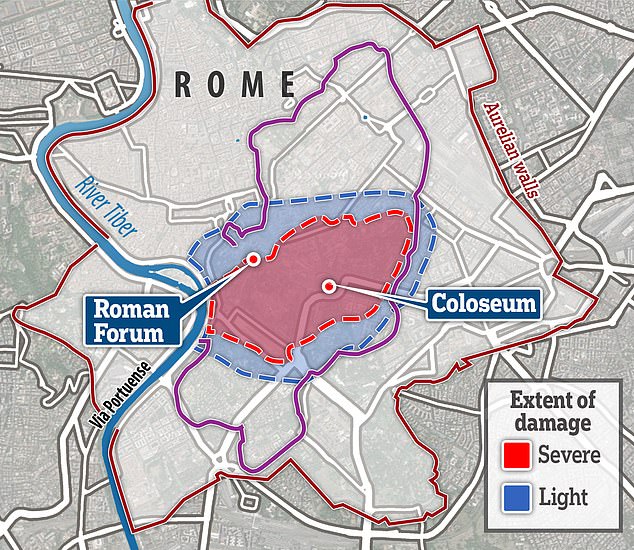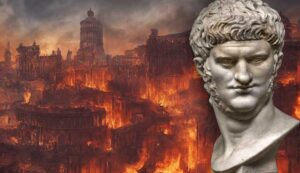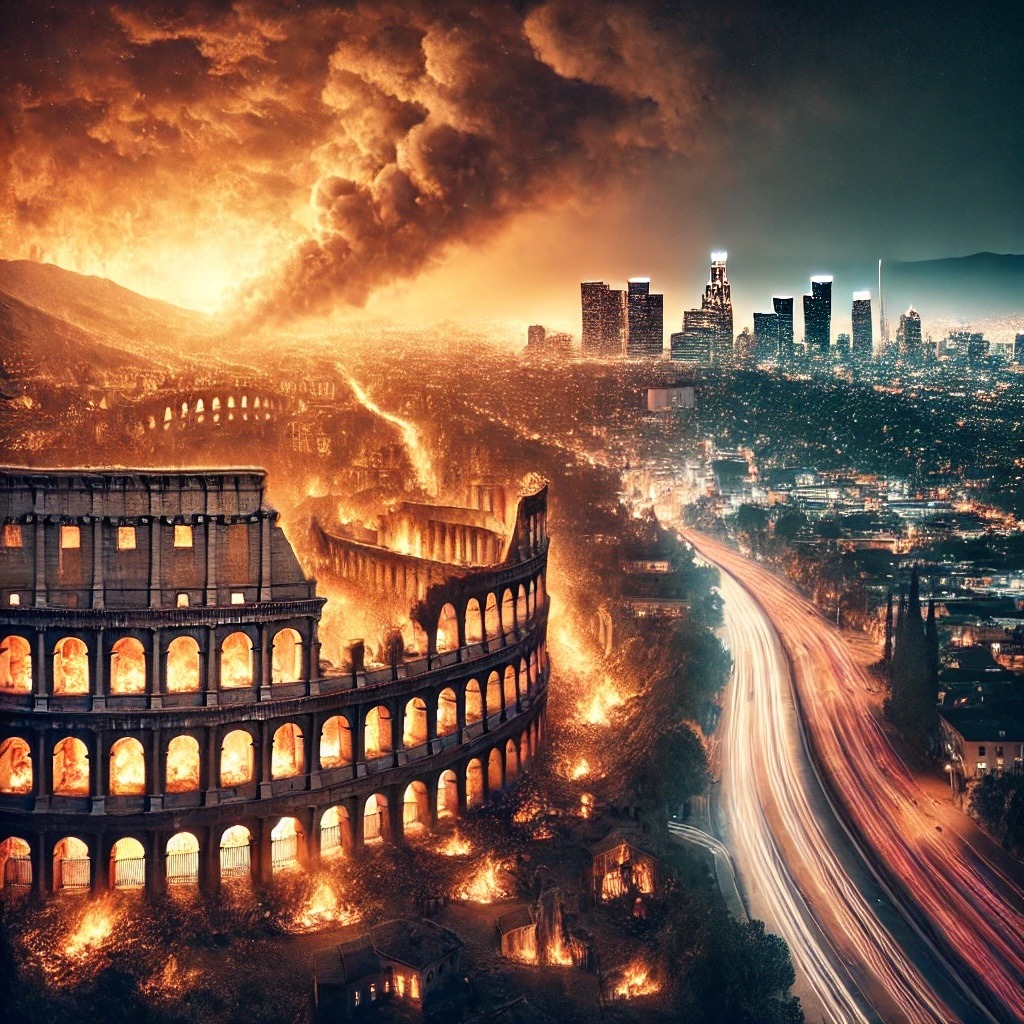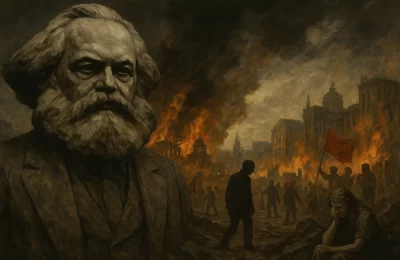Rome burned for six days in the summer of AD 64. Flames devoured ten of its fourteen districts, and the city that had been the beating heart of an empire was reduced to rubble and ash. Emperor Nero returned from his villa in Antium to oversee relief efforts—or so the official version goes. History remembers him differently.

Some say he watched the inferno from a rooftop, singing of Troy’s destruction, a performance as self-absorbed as it was tone-deaf. Others whisper that he orchestrated the fire to clear space for his masterpiece: the Domus Aurea, a golden palace so extravagant it would dazzle the gods themselves. Whether these stories are true or slander from political rivals, one thing is clear: Nero’s Rome wasn’t just a city on fire. It was a leader’s legacy burning before his people’s eyes.
I couldn’t help but think of Nero as I watched footage of the latest wildfire tearing through Los Angeles. Smoke filled the air, and families evacuated in droves, leaving behind homes that might not be there tomorrow. But it wasn’t just the hills that were burning. Los Angeles, like Rome, is a city on fire—its heart consumed not only by flames but by a crisis of leadership, vision, and priorities.
Rome’s Nero: A Leader for Himself
Nero was the ultimate showman. His reign was marked by excess and spectacle: festivals, games, and grand architectural projects. But beneath the glittering surface was a leader hopelessly out of touch with the needs of his people. When Rome burned, his response wasn’t to rebuild for the masses. It was to create a monument to his own vanity—a golden palace surrounded by sprawling gardens.

Nero’s leadership revealed a simple truth: he wasn’t interested in the welfare of his people. He was interested in legacy. He wanted history to remember him, even if it meant those around him suffered in the process. When whispers spread that he had started the fire, Nero didn’t confront the rumor. He deflected, scapegoating a small, powerless group: Christians. They were tortured, crucified, and burned alive, their deaths lighting Nero’s gardens at night.
California’s Newsom: A Modern Nero?
Governor Gavin Newsom, like Nero, leads a city—and a state—on fire. In 2021, over half the fires in Los Angeles were linked to homeless encampments (Serna, 2021). Yet despite the glaring connection between these small-scale fires and the larger social crisis, Newsom’s administration has often chosen optics over solutions. Sweeping encampments gives the illusion of action, but it doesn’t address the causes of homelessness: an unaffordable housing market, a failing mental health system, and addiction that goes untreated.
Instead, Newsom sells the promise of “California for All,” much like Nero sold the promise of a rebuilt Rome. His initiatives are polished and ambitious: “Los Angeles 2.0,” a Smart City vision of AI-driven infrastructure and green technology. It’s as glittering as Nero’s golden palace. But for whom is it built? Will it serve the tens of thousands sleeping in tents and cars—or will it serve those in skyscrapers, looking down at the smoke rising from below?
Leadership in Crisis: Showman or Servant?
Nero and Newsom represent two starkly different kinds of leadership: the showman and the servant. The showman performs, dazzling the audience with grand gestures and promises of a brighter future. But when the curtain falls, the problems remain.
The servant, by contrast, rolls up their sleeves. Nehemiah comes to mind: a leader who rebuilt Jerusalem’s walls not for his own glory but for the protection of his people. He didn’t stand above them; he stood among them, sword in one hand and trowel in the other (Nehemiah 4:17). His leadership wasn’t about spectacle. It was about service.
Jesus is, of course, the ultimate example. His leadership wasn’t marked by golden palaces or Smart City visions but by humility and sacrifice. He washed the feet of His disciples (John 13:14-15). He fed the hungry (Mark 6:30-44) and healed the broken (Luke 17:11-19). True leadership, He showed us, isn’t about what you build for yourself. It’s about what you build for others.
The Fire Beneath the Flames
What makes Los Angeles’ fires so tragic isn’t just the destruction they cause—it’s what they reveal. Fire has a way of laying bare the truth. When Rome burned, it exposed Nero’s vanity. When Los Angeles burns, it exposes a city that has failed its most vulnerable.
The homeless crisis in LA is a slow-burning fire that has been smoldering for decades. Over 75,000 people live without shelter in Los Angeles County (LAHSA, 2023). Their encampments dot the city, invisible to many until tragedy strikes—until a cooking accident sparks a blaze, or a tent city is swept away like yesterday’s ashes. These are the fires no one wants to talk about because they force us to confront uncomfortable truths about how we treat the “least of these” (Matthew 25:40).
A Choice in the Ashes
Rome didn’t need Nero’s golden palace. It needed fireproofing, better housing, and a leader who cared more about the people in the streets than his name in history. Los Angeles doesn’t need another glitzy Smart City proposal. It needs homes people can afford. It needs mental health resources, addiction treatment, and a willingness to prioritize the unseen over the celebrated.
When the fires come, whether in Rome or Los Angeles, they ask a question: What kind of leader will you be? Will you build for yourself or for others? Will you perform, or will you serve?
The answer to that question doesn’t just shape a city. It shapes a legacy. Rome’s fire revealed Nero for who he was—a man who built for himself and left his people to suffer. The fires of Los Angeles are revealing the same truth about its leaders.
But the story isn’t over. The flames will either consume the city’s soul—or purify it for something greater. As for Newsom and LA’s leadership? The fire is still burning. And history is watching.
References
Los Angeles Homeless Services Authority [LAHSA]. (2023). 2023 Greater Los Angeles homeless count results. https://www.lahsa.org
Serna, J. (2021, July 28). Fires linked to homeless people are surging in L.A. Officials are trying to figure out what to do. Los Angeles Times. https://www.latimes.com







